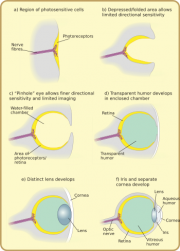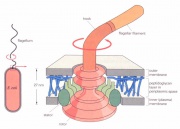Argument from irreducible complexity
The concept of irreducible complexity is that a structure formed in an organism is too complex to have formed in gradual steps, or that a complex structure couldn't have formed in gradual steps because the structure is useless in anything but a complete state.
The Eye
The eye is often cited in these arguments due to its high complexity. However a possible evolutionary course for the eye has been produced, which due to the nature of this argument, refutes the argument.
The steps that the eye evolves through are as follows (and are diagrammed in the picture):
1. A simple photosensitive nerve
2. A concave depression which allows for directional sensitivity
3. A spherical enclosed area with a pinhole input point, which allows for more precise directional sensitivity
4. A transparent humor develops inside the enclosed area.
5. A lens forms, allowing for the focusing of input light
6. Tertiary structures form, including irises which greater increase the capability of the eye.
Flagella
Another common argument is that of the flagella, which is a type of microbe that has what an engineer would call an outboard motor. The typical claim is that such motor, if missing any one part, doesn't work, and that because evolution requires a change to be beneficial so that it is passed on. They claim that a useless motor doesn't provide much benefit, overlooking two possibilities.The first possibility is that it could have evolved for a different reason. It has been pointed out that a typical pump is of similar design and uses 10 of the parts used in the final flagella outboard motor. They argue that there are 30 extra parts in the final motor, and that the parts in question are used entirely differently from their original purpose. They ask how such an outrageous event could occur to make these things change purpose. It's possible that they adapted to a different purpose and added parts because such was advantageous to do so, a possibility that they dismiss completely.
The second possibility is that it evolved incomplete. Only some parts of it were changed at a time. Because even slight jiggling is preferable over no motion at all. They claim that such is impossible because lacking a single part an outboard motor won't work. However what they overlook is that it doesn't work as well. Parts of the outboard motor can be removed and still have it do something, perhaps not as much as the entire engine together, but even just whirring engines are better than none at all from an evolutionary perspective.
External Links
Wikipedia Wikipedia has a number of arguments against irreducible complexity on its page, including detailed sources and links to other arguments.
This site costs a lot of money in bandwidth and resources. We are glad to bring it to you free, but would you consider helping support our site by making a donation? Any amount would go a long way towards helping us continue to provide this useful service to the community.
Click on the Paypal button below to donate. Your support is most appreciated! |
|---|




